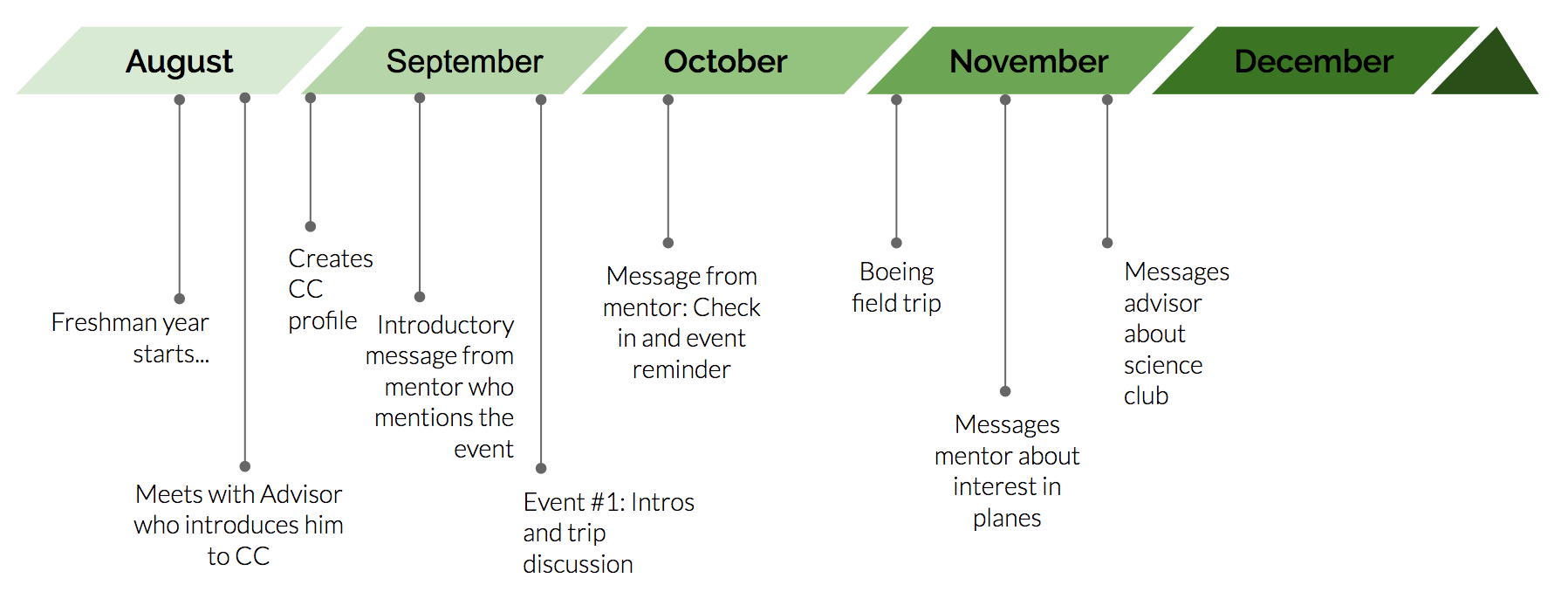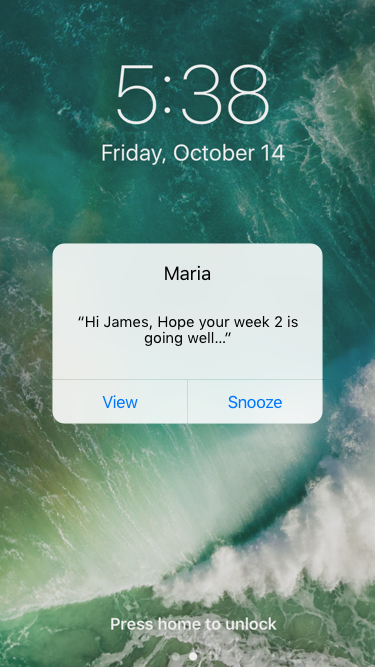
Designing for Behavior Change
Designing for Behavior Change - College Connect App
Overview
Design Question How can we get high school students who would normally not attend college, due to various obstacles, to consider going to college and act on it in the future?
Target Audience: Freshmen/Sophomore year high school students from low income and/or minority households.
Research and design methods used: Literature Reviews | Rapid Sketching | Personas | Wireframes | Cognitive Walkthrough
It is getting increasingly more costly for people to attend college. People who don’t obtain a bachelor's degree are almost 4 times as likely to be unemployed than someone with a degree, 4 times as likely to be living in poverty and earn about half the salary than their peers with a degree. The demographics who have the most difficulty attending college come from low-income and/or minority households. Not attending college ultimately perpetuates the cycle of keeping these demographics in the low socio-economic status.
We would like to tackle this question with an early intervention solution. Our idea is to enable them early on, when they haven’t yet decided, “I will not attend college”, and instead think, “College will be good for my future, and I will consider and attempt to attend.”

#1
Research. Personas. Design principles.
Literature Reviews and Surveys
Our research draws heavily from published articles, blogs and theories like the Transtheoretical Model and Stages of Change (Prochaska et. al.) and the Theory of Planned Behavior (Davis et. al.) As per the Theory of Planned Behavior "human action is influenced by three main factors: a favorable and unfavorable evaluation of the behavior (attitude toward the behavior), perceived social pressure to perform or not perform the behavior (subjective norm) and self-efficacy in relation to the behavior (perceived behavioral control)." This project intends to be an early intervention to stop high school students from reaching a decision point where they believe that attending college is not something they can achieve. We targeted students who are still ambivalent about college; those who are undecided about whether or not they will attend, but are considering it as an option. As per the Stages of Change theory, we believe these students were in the "Contemplation Stage" (intends to take action in the next 6 months) of going to college, and we would like to move them to the "Preparation Stage" (intends to take action in the next 30 days and has taken some behavioral steps in that direction) with the aid of their advisor and mentors, which is a big part of our intervention program.
We further validated our theoretical findings by surveying first generation college students and create a stronger mental model of the target audience.
Personas
Design Principles
Taking into consideration Schwarzer's Social Cognitive Theory (that behavior change is made possible by a personal sense of control), we decided to create a solution that has a map to college for James with strategic triggers to take action and reach milestones. The key question we asked ourselves as we designed the principles to guide the project was - What will James ask here? What brings him back? How so we motivate him intrinsically as well extrinsically? In an attempt to answer these questions and guide the development of our solution, we devised the following principles.
Increase self-efficacy of the students by enabling vicarious experiences and providing verbal persuasion.
Shape social outcome expectancy. Change the subjective norm around them and provide them with opportunities to socialize, so they are engaged with the system.
Provide self-evaluative outcome expectations that are pro-college.
Encourage progress through achievable goals. Increase “difficulty” of goals as students achieve more.
Lower perceived barriers towards attending college.

#2
User flow. Wireframes.
User Flow
Based on research and feedback our solution panned out to be a long term endeavor that will span 4 years of high school. To ensure the stickiness of the solution and make it accessible to all our intended users we decided to develop it in the form of a mobile application.
The application will nudge and motivate users to build their career paths and development strategies based on taking up extra curricular activities, staying informed, networking, attending relevant events etc. We are also aiming to increase their interaction with teachers and advisors through activities and milestones which they can achieve with their help. By pairing them with a mentor not only will they be reminded to stay on track but will have someone more relatable to talk to and ask questions.
The course of James' high school progress without timely intervention is highlighted in red, while the effect of our solution, College Connect application, is highlighted in green.

Our solution College Connect is a mobile application designed to lower the perceived barriers to attending college among high school freshmen and sophomores. It is designed to provide them with a support network of mentors, peers and advisor in an environment that nudges and encourages them to take advantage of these resources. While the solution itself is a 4 year program, the wireframes subsequently created were scoped to cover the first 2 semesters of high school.

Wireframes
Some of the screens from the end to end walkthrough have been shown below. They were evaluated by users in a cognitive walkthrough.













User Feedback
The application was a success with our participants. While some hinted initially that they would not trust the mentor when connected through an app, their reservations were alleviated when the advisor first introduced them to the mentor instead. Having peer forums and knowing how many students are actively participating in College Connect was helpful information for the users to take part in the program. Some of them said:
“That [goal setting] stuff is beneficial, I remember the struggle for that. Your UI is pretty strong too.”
“I would have [used it]. I would have used my mentor a lot and asked him a lot of questions.”
“I think it’s a good assistant for someone like me, and has good resources [...] as kids we need a lot of reminders I guess.”
Key Takeaways
Designing for a long term program was not easy. Designing for behavior change takes patience and a deep understanding of one's motivations, comfort zone and surrounding. We had to always bear in mind the guiding theoretical principles as well as the psyche of the adolescent user. And it is always tricky when interacting with under 18 users for usability tests and interviews. This was one of the first hurdles we had to overcome during our research phase.
Phase 1 of this class project has been successfully completed. Please keep watching this space for phase 2 - application development.

